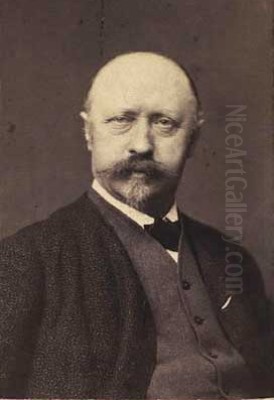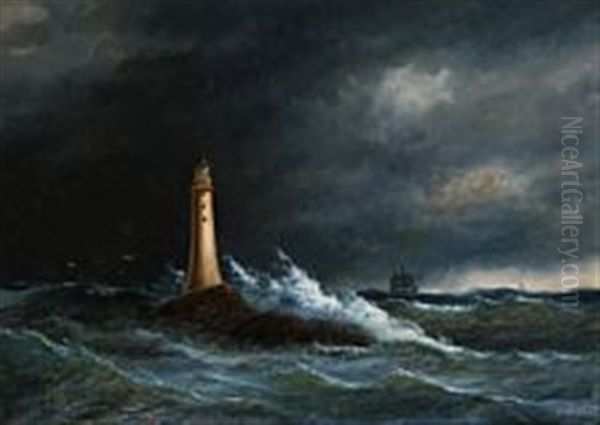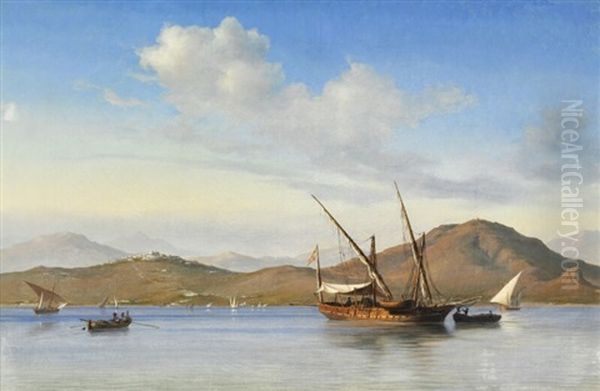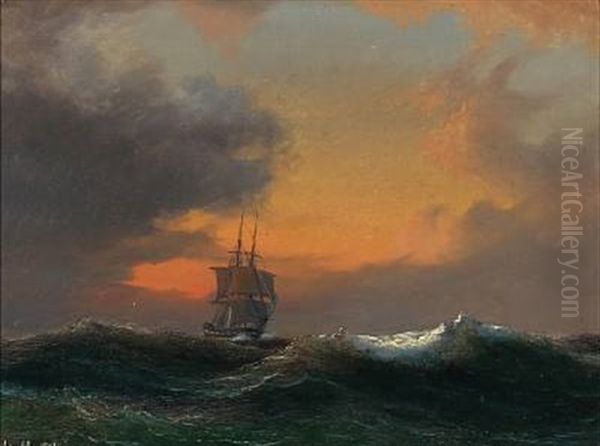
Daniel Hermann Anton Melbye stands as a pivotal figure in 19th-century Danish art, celebrated primarily as a master of marine painting. Born in Copenhagen on February 13, 1818, and passing away in Paris on January 10, 1875, his life and career bridged the later years of the Danish Golden Age and the broader currents of European Romanticism and emerging Realism. Melbye's canvases are renowned for their dramatic intensity, meticulous attention to nautical detail, and profound understanding of the sea's ever-changing moods, earning him international acclaim and the patronage of royalty and collectors across Europe.
Early Life and Artistic Inclinations
Born into a Denmark experiencing a flourishing of arts and culture known as the Danish Golden Age, Anton Melbye's initial aspirations lay not in art, but in the sea itself. His father, Jacob Buntzen Melbye, was a royal customs officer. Young Anton harboured dreams of becoming a naval officer, a path seemingly fitting for someone who would later dedicate his life to depicting maritime subjects. However, his ambitions were curtailed by poor eyesight, specifically myopia (near-sightedness), which disqualified him from naval service.
This setback redirected Melbye's path. Alongside a talent for music, he possessed a strong inclination towards the visual arts. He initially trained as a shipbuilder, a practical education that undoubtedly provided him with an intimate knowledge of vessel construction and rigging – details that would later infuse his paintings with remarkable accuracy. Yet, the pull towards painting proved stronger. Recognizing his artistic potential, he sought formal training to hone his skills.
Academic Foundations: The Royal Academy and Eckersberg
In 1838, Melbye enrolled at the prestigious Royal Danish Academy of Fine Arts in Copenhagen. This institution was the heart of the Danish Golden Age, fostering a generation of artists who excelled in various genres. Crucially, Melbye became a student of Christoffer Wilhelm Eckersberg (1783-1853), often hailed as the "Father of Danish Painting." Eckersberg, himself a student of Jacques-Louis David in Paris, instilled in his pupils a rigorous approach based on careful observation, precise draughtsmanship, and a deep respect for depicting reality, albeit often through an idealized lens.

Studying under Eckersberg placed Melbye within a vibrant artistic milieu. Contemporaries at the Academy or active during this period included painters like Christen Købke (1810-1848), known for his sensitive portraits and local landscapes, and Martinus Rørbye (1803-1848), celebrated for his travel paintings and genre scenes. While Melbye would ultimately specialize in marine subjects, Eckersberg's emphasis on meticulous study from nature and technical proficiency provided a crucial foundation for his future work. Even as Melbye embraced the drama of Romanticism, the underlying structure and detail in his work often reflected his Golden Age training.
The Lure of the Ocean: Launching a Marine Painter's Career
Melbye quickly gravitated towards marine painting, a genre that allowed him to combine his love for the sea with his artistic talents. He began exhibiting his works, and his skill was soon recognized. As early as 1840, he started undertaking sea voyages specifically to study the behaviour of ships and the dynamic nature of water and waves. He was known to travel with sketchbooks and watercolour kits, capturing fleeting effects of light and weather directly from observation.
These early studies and voyages were instrumental in developing his signature style. He sought not just to depict ships accurately, but to convey the atmosphere and emotional power of the maritime environment – from tranquil moonlit harbours to tempestuous storms lashing against rocky coasts. His dedication and talent yielded early success; in 1843, he was awarded the prestigious Neuhausen Prize by the Academy for one of his marine paintings. This was followed in 1846 by the Thorvaldsen Medal, the Academy's highest distinction, cementing his reputation as a leading young artist in Denmark.
Defining the Melbye Style: Romanticism Meets Realism
Anton Melbye's artistic approach is best characterized as a compelling fusion of Romanticism and Realism. He embraced the Romantic fascination with nature's power, drama, and sublime beauty. His seascapes often feature dramatic lighting, turbulent skies, and towering waves, evoking a sense of awe and sometimes peril. He was a master at capturing atmospheric effects – the glint of moonlight on water, the haze of a distant horizon, the spray kicked up by a ship battling the wind.
This Romantic sensibility was, however, firmly anchored in a Realist's attention to detail, particularly concerning maritime technology. Thanks to his early training and dedicated study, Melbye depicted ships with exceptional accuracy. The complex rigging, the construction of the hulls, the way sails caught the wind – all were rendered with a convincing precision that appealed to naval experts and lay viewers alike. This combination set him apart; his work possessed both emotional impact and technical credibility.

His style can be seen in relation to other great European marine painters. While perhaps less overtly tumultuous than some works by Britain's J.M.W. Turner (1775-1851), Melbye shared a Romantic interest in light and atmosphere. He also worked within a tradition influenced by 17th-century Dutch masters of the sea, but brought a distinctly 19th-century dramatic flair, comparable in some respects to French contemporaries like Théodore Gudin (1802-1880) or the Russian master of the sea, Ivan Aivazovsky (1817-1900), though Melbye often maintained a greater degree of nautical specificity than Aivazovsky.
Notable Works and Artistic Vision
Melbye's oeuvre includes numerous celebrated paintings that showcase his distinct style. Eddystone Lighthouse, painted in 1846, is a powerful example of his Romantic leanings. It depicts the famous lighthouse off the coast of Cornwall, England, standing resolute against a dramatic sea and sky. The work conveys a sense of isolation and the enduring struggle between human ingenuity and the forces of nature.
Another significant work, sometimes titled The English Fleet Passing through the Strait of Gibraltar (c. 1845-1850s – exact dating varies), demonstrates his skill in depicting naval power and contemporary events. Often associated with the period leading up to or during the Crimean War, such paintings captured the grandeur of modern navies, blending precise ship portraits with atmospheric settings. His ability to render the subtle play of light on water is evident in works like A Calm Night (1847) or Moonlit Coastal Scene, where tranquility and mystery pervade the canvas.
He frequently painted scenes from the Øresund (the Sound), the strait between Denmark and Sweden, often featuring Kronborg Castle at Elsinore. Shipping in the Sound near Elsinore became a recurring theme, allowing him to explore different weather conditions and times of day in a familiar setting. His travels later provided new subjects, such as View of Constantinople, capturing the exotic allure of the Ottoman capital. Works like French Man-of-War firing a Salute combined naval ceremony with his characteristic atmospheric depth.
Seeking Wider Horizons: Paris and International Recognition
Seeking broader opportunities and recognition, Melbye moved to Paris in 1847, residing there for over a decade until 1858, though he would return later in life. Paris was then the undisputed centre of the European art world, and Melbye successfully established himself there. He exhibited at the prestigious Paris Salon, gaining critical acclaim and attracting influential patrons. His dramatic yet detailed marine paintings found favour with French audiences.

His time abroad included significant travels. In 1853, he journeyed to Constantinople (modern-day Istanbul), the capital of the Ottoman Empire. This voyage provided him with fresh inspiration and exotic subject matter, reflected in several paintings depicting the Bosphorus and the city's distinctive skyline. He also spent time in Hamburg and Altona, German cities with strong maritime connections, where he cultivated a network of clients and collectors, regularly participating in local exhibitions.
His international reputation grew, and his patrons included European royalty. Notably, Emperor Napoleon III of France acquired some of his works. He also maintained connections with the Danish Royal Family, who had supported him early in his career. In 1858, his achievements were recognized with the Knight's Cross of the Order of the Dannebrog, a significant Danish honour.
A Dynasty of Marine Painters: The Melbye Brothers
Anton Melbye was not the only artist in his family; he played a crucial role in fostering the careers of his two younger brothers, Vilhelm Melbye (1824-1882) and Fritz Melbye (1826-1869). Anton served as a teacher and mentor to both, guiding their development as marine painters. The Melbye brothers formed something of a dynasty specializing in maritime art.
Vilhelm Melbye followed closely in Anton's footsteps, also studying at the Danish Academy and specializing in marine painting. He travelled extensively, including voyages to London, where he gained considerable success. His style often mirrors Anton's blend of Romanticism and detailed realism, though perhaps sometimes with a slightly calmer sensibility.
Fritz Melbye also became a marine painter under Anton's guidance. His career took a more adventurous path. He travelled to the Danish West Indies (now the U.S. Virgin Islands) in 1849, seeking tropical subjects. It was there, on the island of St. Thomas, that he would encounter a young artist who would go on to achieve global fame.
An Unlikely Tutelage: Camille Pissarro
In St. Thomas around 1850, Fritz Melbye met a young, aspiring Danish-French artist named Jacob Abraham Camille Pissarro (1830-1903). Pissarro, then working as a clerk but passionate about drawing, was inspired by Fritz. Abandoning his job, Pissarro travelled with Fritz Melbye to Caracas, Venezuela, in 1852, where they spent two years sketching and painting together. Fritz acted as Pissarro's first real mentor.
Upon returning to Europe, Pissarro made his way to Paris in 1855. Seeking further instruction, he connected with his first mentor's older brother, Anton Melbye. For a time, Pissarro studied with Anton, who was by then an established figure in the Paris art scene. When Pissarro first exhibited at the Paris Salon in 1859, he listed himself as a "pupil of A. Melbye."
While Pissarro would soon move away from Melbye's tighter, more Romantic style, embracing the influence of artists like Jean-Baptiste-Camille Corot (1796-1875) and Gustave Courbet (1819-1877) and eventually becoming a founding figure of Impressionism, his initial formal training in Paris was under Anton Melbye. This connection highlights Melbye's standing in the Parisian art world and provides a fascinating link between the Danish Golden Age tradition and the birth of French Impressionism. The influence likely lay in Melbye's emphasis on capturing light and atmosphere, even if Pissarro later pursued these goals through radically different techniques.
Later Life, Continued Work, and Legacy
Anton Melbye eventually returned to Denmark but continued to travel and work internationally. He spent periods in Hamburg, London, and Paris. He remained a prolific painter, his skill and reputation largely undiminished. His works continued to be sought after by collectors appreciative of his dramatic yet refined depictions of the sea.
He passed away in Paris on January 10, 1875, at the age of 56. He left behind a significant body of work that secured his place as one of Scandinavia's foremost marine painters. His influence extended beyond his immediate students, including his brothers and Pissarro, impacting the course of marine painting in Denmark and contributing to the genre's popularity throughout the 19th century.
Anton Melbye's legacy rests on his ability to synthesize the meticulous observation encouraged by his Danish Golden Age training under Eckersberg with the dramatic sensibility of European Romanticism. He captured the power, beauty, and technical intricacies of the maritime world with a unique vision. His paintings remain compelling testaments to the age of sail and steam, rendered with both technical brilliance and profound emotional resonance. His work is held in major museum collections in Denmark, including the Statens Museum for Kunst (National Gallery of Denmark), and internationally, ensuring his contribution to art history continues to be recognized and appreciated. He stands as a bridge figure, connecting the specific national context of the Danish Golden Age to the broader international currents of 19th-century art.